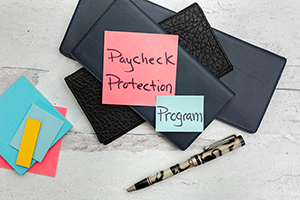
The Paycheck Protection Program (PPP) has been enormously popular – $349 billion of available funds were loaned to small businesses and nonprofit organizations within a two-week period, and negotiations are taking place that may provide additional funding for the program. As companies begin to receive funding from the PPP, tracking qualified costs to maximize debt forgiveness is top of mind for many loan recipients. Failure to accurately track funds could result in a potential misuse of loan proceeds, resulting in receiving only a portion of the maximum loan forgiveness amount. Below are several considerations for tracking funds and what costs are eligible for forgiveness. Only expenditures made during the eight-week period immediately following the receipt of funds potentially qualify for forgiveness under this program.
Tracking funds tips for debt relief:
- Retain documentation supporting all payroll and other eligible costs transactions. These may include payment receipts, invoices, insurance filings, payroll tax forms and filings (W-2s, Forms 941, etc.) and account transcripts.
- Record transactions and reconcile accounts diligently. Consider opening specific COVID-19 line items within your accounting software, separating them from line items kept in the normal course of business.
- Consider opening a new bank account to receive and separate PPP loan funds, supporting the tracking of expenses.
- Maintain a spreadsheet separating payroll and other eligible costs to ensure that a minimum of 75% of loan proceeds are being used for payroll costs.
- Diligently monitor the SBA website for frequent updates and feel free to reach out to the ML&R team with any questions.
What costs are eligible for forgiveness during the eight-week period?
Payroll costs include:
- Salary, wage, commission, or similar compensation;
-
- Payment of cash tip or equivalent;
- Payment for vacation, parental, family, medical, or sick leave;
- Allowance for dismissal or separation;
- Payment required for the provisions of group health care benefits, including insurance premiums;
- Payment of any retirement benefit;
- Payment of state or local tax assessed on the compensation of employees; or
- Compensation to or income of a sole proprietor or independent contractor that is a wage, commission, income, net earnings from self-employment, or similar compensation.
Other forgivable costs include:
- Rent and lease payments, defined as rent obligated under a leasing agreement in force before February 15, 2020.
- Utilities, as defined as payment for the service of electricity, gas, water, transportation, telephone, or internet access for which service began before February 15, 2020.
- Mortgage interest incurred before February 15, 2020.
What causes a reduction of loan forgiveness?
As the PPP program is designed to maintain payroll through the covered period, reductions in salaries or workforce could cause debt forgiveness to be reduced. However, if the business can re-hire employees and reinstate salaries by June 30, 2020, the business is not required to reduce the loan forgiveness.
Salary Reduction
- The amount of loan forgiveness will be proportionally reduced to employee compensation, if compensation is reduced in excess of 25% as of the most recent full quarter. Please note this only includes employees who earned less than an annualized rate of $100,000 a year during 2019.
Workforce Reduction
- If the company reduces its workforce, loan forgiveness will be reduced by the quotient of the following formula:
- Average number of monthly full-time equivalent employees during the covered period; divided by (at the election of the borrower)
- the average number of full-time equivalent employees per month employed by the eligible recipient during the period beginning on February 15, 2019 and ending on June 30, 2019; or the average number of full-time equivalent employees per month employed by the eligible recipient during the period beginning on January 1, 2020 and ending on February 29, 2020; or
- Average number of monthly full-time equivalent employees during the covered period; divided by (at the election of the borrower)
- If you are a seasonal employer, the measurement period is the period beginning February 15, 2019 and ending on June 30, 2019.
We Are Here to Help
Please feel free to contact us with any questions you may have or you can visit ML&R’s dedicated COVID-19 page for additional information and resources regarding the Paycheck Protection Program and other provisions of the CARES Act.




